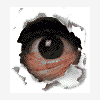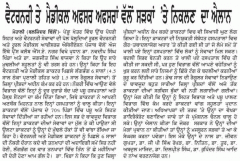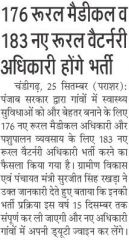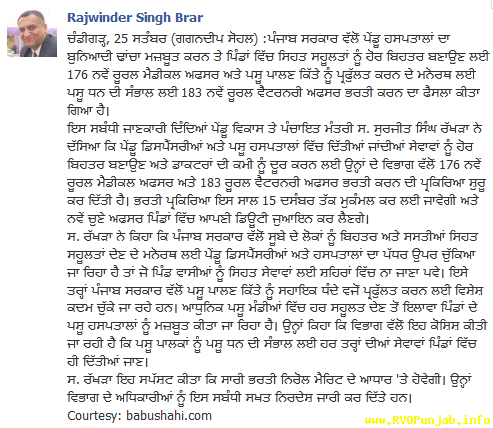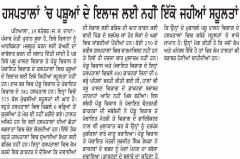LAWS RELATING TO ANIMAL RIGHTS
Indian Laws
If properly used, the law can be your most effective weapon against animal exploitation. India has one of the most comprehensive set of animal protection laws in the world. There are detailed codes of conduct governing our use and treatment of both domestic and wild animals.
In fact, India is unique in that animal welfare is enshrined in our constitution and every citizen is required to show compassion to all living beings. Unfortunately, in spite of the importance accorded to animal protection by our founding fathers, animal protection laws have remained mere pieces of paper.
Few are even aware of the existence of these laws, leave alone how to use them. However with the animal welfare movement gaining momentum, numerous cases are now being brought and fought in court.
In order to successfully challenge cruelty, it is useful to know the law as it applies to animals.
SACRIFICE AND ANIMALS
One is well within one's rights to follow one's religion and all the rituals prescribed, but not at the expense of others – humans and animals. in fact, several states in india have laws prohibiting animal sacrifice. here is a list of the states that have laws prohibiting the sacrifice of any bird or animal :
karnataka
tamil nadu
andhra pradesh
orissa
gujarat
himachal pradesh
if you happen to be in any one of these states and are privy to information about people sacrificing animals or birds, do contact the nearest police station and lodge an fir. these animals depend on you to voice their pain.
all animal sacrifices and rituals have been deemed illegal under the magic remedies act.
the sacrifice of cattle is specifically illegal under the cow protection laws. there is also a ruling by the west bengal high court making it illegal to sacrifice cattle on the occasion of id. the festival of jallikattu in karnataka that uses bulls is illegal.
no wild animals or birds may be used for sacrifice or any religious ritual as it is strictly forbidden under the wildlife protection act to catch, keep or kill them. this includes :
snakes during nag panchami.
monkeys confined in hanuman mandirs.
foxes trapped for makar sankranti in karnataka.
poaching as part of tribal festivals and so on.
all of these are illegal and punishable with a fine of rs 25,000 and years in jail.
people should realise that in a modern humane society, the sacrifice of animals on the name of religion or ancient rituals, is merely moving back the clock of civilisation and is a reflection of a people with little sensitivity and a crude sensibility.
BIRDS
Birds are covered under the Wildlife Protection Act (WPA) 1972 making it illegal to catch, keep, kill, buy / sell birds or damage their nests.
All indigenous bird species are covered under this Act.
Trade in foreign birds is restricted by CITES (Convention of International Trade in Endangered Species).
There is an international protocol to which India is a signatory which assures full protection to all migratory species, making it illegal to trap, capture, keep, kill or trade these birds.
Parrots are not indigenous to India. The green birds that we mistakenly refer to as parrots are actually parakeets. It is illegal to keep them in cages. So called fortune tellers often use these birds. The punishment is a fine and upto 5 years in jail.
It is illegal to keep any birds in captivity with the only exceptions being lovebirds and blue rock pigeons.
It is illegal to farm or keep peacocks. Areas that have natural populations of these birds, may not enclose or attempt to confine them.
Pheasants, jungle fowl and partridges ( teetar) are protected under the WPA. It is illegal to hunt, kill, buy, sell, eat or serve them.
It is illegal to colour birds (as is done by bird sellers to make them look more attractive) as the chemical colour is toxic and possibly carcinogenic.
It is illegal to cut the feathers of birds as this amounts to maiming them which is a cognisable offence under IPC Section 428/429.
Cock fighting is a cognisable offence under PCA. Therefore rearing and training birds to fight is similarly illegal.
It is illegal to keep or train falcons and hawks. Since it is illegal to buy or keep birds, it is illegal to organise bird release ceremonies to mark occasions where the birds have been procured by sale.
It is illegal to show caged birds in ads,movies or serials.
CONTESTS & ANIMALS
Under the Prevention of Cruelty (PCA) Act Section 11, it is a cognisable offence to use animals for animal contests. The penalty is a fine and / or jail upto 2 years.
All of the following are illegal:
Snake and mongoose fights.
Ram fights.
Bull fights (Dhirio in Goa).
Cock fights.
Oxen races.
Dog races.
Both the owner as well as the organiser of the contest are liable. It is illegal to use or allow the use of any property or premises for the purpose of animal contests. It is also illegal to bet on the outcome of such illegal animal contests.
DAIRY ANIMALS
In cities or towns with a population exceeding 1 lakh:
Every person with premises holding more than 5 cattle kept for the purpose of profit must be registered with the Veterinary Deptt of the State Govt or a local authority specified by the State Govt.
Every registration application must supply full information on the number and types of animals to be kept, size of area, flooring and ventilation,supply of food and water, disinfecton, drainage,waste disposal and any other relevant detail.
If the registering authority is satisfied about the welfare of the animals,the registration certificate will be issued.
Every registraton certificate is valid for 3 years after which an application for renewal must be made.
Every registered premises may at any time be inspected by an authorised vety or public health officer of the local or State Govt.
If the premises are not properly maintained, the registration can be cancelled.
Wherever milch cattle are kept, the owner must display a copy in the local language of Section 12 of the Preventon of Cruelty To Animals Act prohibiting the use of phooka or doom dev.
It is illegal to keep cattle chained to the railing of sidewalks. Under the law, milch animals are required to be provided proper shelter (PCA Section 11). Under the local Municipal Corporation Act (e.g. The Delhi Municipal Corporation Act 1954), tethering cattle on any public street is prohibited. Such cattle may be impounded under the Cattle Trespassing Act 1871.
Dairy owners must provide proper shelter with provisions to protect the animals against heat, cold and rain (PCA Section 11).
Under the law, owners must provide adequate food [PCA Section 11). Owners who leave their cattle to forage in rubbish dumps can be fined and jailed upto 3 months. These cattle can be impounded. Owners will have to pay a fine for their release. Dairies should be checked for sufficient number of food and water troughs. Failure to provide these are a punishable offence.
It is illegal to kill calves (State Cow Preservation Act) . Dairy owners that kill male calves may be fined, jailed or both. The dairy can be closed down.
It is illegal to administer animals any injurious drugs (PCA Section 11). It is a cognisable offence to use injections of any kind or conduct any operation called Phooka or Doom Dev to 'improve' lactation [PCA Section 12). The use of Oxytocin (Schedule H Drug which may not be purchased without a prescription) injections can be punished with a fine, jail or both. The manufacturer, supplier and dairy can all be punished with a fine of Rs 1000 and upto 2 years in jail. The animals shall be forfeited by the government. S
It is illegal to sell old, dry or sick cattle for the purpose of slaughter (local Cattle Preservation Acts). Offenders can be punished with a fine, jail or both.
It is illegal to abandon old, dry or sick cattle (PCA Section 11) as it puts them in circumstances likely to cause their death from starvation. Penalty is a fine of Rs 100/- or 3 months in jail or both.
No livestock may graze in any sanctuary area without being immunised.
No livestock may graze in National Parks and no livestock may be allowed entry therein except as a vehicle eg bullock cart of an authorised person.
DOMESTIC ANIMALS
One often sees pets ill treated and abused by pet owners, but the owners often go unpunished. Even well meaning people do nothing out of ignorance. The first way to fight this kind of cruelty is by being aware of the laws that protect pets. Responsible pet ownership is not just desirable, it is required under the law. Under the Prevention of Cruelty To Animals Act 1960 (PCA) all of the following are punishable offences:
Beating, kicking, overriding, torturing or causing any animal pain or suffering by the owner or any other person. This means you may not hit or hurt your pet or any other animal. Offenders may be reported to the police. The penalty is a fine of Rs 100/-or jail up to three months or both. Here is a list of several other acts of cruelty that are punishable under law: Caging or confining an animal in a cage or enclosure too small to allow reasonable movement. Offenders may be reported to the police. The penalty is a fine of Rs 100 and jail up to 3 months or both. Tying with a short or very heavy chain. Penalty is a fine of RS 100 and up to 3 months in jail or both. Keeping the animal constantly confined or tied for extended periods thereby denying it the opportunity to exercise. Punishable with a fine of RS 100/- and up to 3 months in jail or both. Failure to provide sufficient food and water to a pet animal. Penalty is a fine of RS 100/- and up to 3 months in jail or both. Failure to provide proper shelter. This means failure to provide protection from the external environment e.g. leaving a dog out in the rain or cold, or no access to shade in summer. Penalty is a fine of RS 100/- and up to 3 months in jail or both. Placing an animal in circumstances that are likely to endanger its life and cause its death from starvation or thirst. This means abandoning an animal in unfamiliar territory or in sickness or old age is illegal. Penalty is a fine of RS 100/- and up to 3 months in jail. Maiming or injuring an animal in any way. Any surgical or invasive procedure without anaesthesia. This would include ear or tail docking. It is a cognisable offence under Section 428/429 of the Indian Penal Code. The penalty is a fine and up to 5 years in jail. Inadequate health care. This includes lack of timely and appropriate veterinary treatment. Using an animal for the purpose of animal fights / contests (cockfights,oxen races, dog races) or baiting. This is a cognisable offence under Section 11(1.9n) Offering for sale or possessing any animal which is suffering from mutilation, starvation, thirst, overcrowding or other ill treatment. This makes it illegal to over-breed dogs or keep pups for sale in poor conditions.
DRAUGHT ANIMALS
Rule 3 of The Prevention of Cruelty To Draught and Pack Animals Rules 1965 lays down maximum loads that animals may carry as well as conditions for their working.
All tangas and bullock carts are required to be registered with the local Corporation to be allowed to ply. This licence number is the only method of identification for these carts. When registering a complaint against them, be sure to get this number. Here is what to look out for:
Overloaded animal or cart. Overloading is illegal (Draught & Pack Animals Rules and PCA Section 11) . Offenders are required to unload the cart / animal. The police has the right to confiscate both the cart and the animal.
Where the route involves going uphill for a distance over 1 km, the specified weights shall be halved.
Weak, limping or injured animal. It is illegal to work a sick or injured animal (PCA Section 11) . In the case of horses, check beneath the saddle area for sores. In the case of bullocks, check the neck area. With the load falling primarily on their necks, a high percentage of bullocks develop neck cancer. An injured animal may be confiscated and impounded at the nearest animal infirmary / shelter / municipal pound.
Frothing at the mouth. It is illegal to work animals when the temperature is above 37 degrees Celsius (Draught & Pack Animal Rules) . This means most summer afternoons.
Obviously exhausted animal. Animals may not be worked for more than 5 hours at a stretch and not for more than a total of 8 hours a day.
When not in use, animals are required to be unharnessed, fed and watered.
Emaciated animal. Owners are required to provide sufficient food for the animal (PCA Section 11) .
Whipping, kicking or beating. It is illegal to hit any animal (PCA Section 11) . Many tanga and bullock cart drivers use sticks with nails on the end. They also poke the stick into the animal's rectum to prod it to go faster. All of this is illegal and punishable with a fine and upto 3 months in jail.
The use of any harness, yoke or bit with spikes, knobs or any sharp projecton which is likely to cause bruises, swellings or pain to the animal is forbidden.
Tangas may not carry more than 4 persons and the driver.
Camels may not be used on the beach. They are desert animals and sea air damages their lungs therefore it is illegal to keep or use them on the shore (PCA Section 11) .
EXPERIMENTAL ANIMALS
The Committee for the Purpose of the Control & Supervision of Experimental Animals (CPCSEA) has laid down specific rules regarding the use of animals for research which all research institutes are required to follow. Failure to do so can result in the animals being confiscated and the Institute losing its licence to test on animals.
The rules specify the following:
Housing
Housing must be in a clean, quiet area.
Enclosures must be large enough to allow opportunity for exercise.
There must be a trained animal attendant to care for the animals.
Arrangements must be made to feed the animals even on holidays.
Nature of Experiments
No duplicative testing is allowed. This means no experiment the result of which is already established may be performed simply for the purpose of exhibition or acquiring manual skills when other means such as books, diagrams, computer models etc. will suffice.
There must be a trained anaesthetist present all through the conduct of the experiment. It is mandatory to give the animal anaesthesia during the conduct of any experiment involving surgery. Pain killing medicine must continue to be given until the animal recovers. Should the anaesthesia wear off and the animal recover consciousness during the experiment, the experiment must be immediately discontinued.
Only a trained veterinary surgeon may perform surgical procedures.
No contract or commercial testing is allowed.
Animals may not be debarked i.e. their vocal chords cut so that they cannot voice any pain.
No poisonous substance may be applied to the animal’s eyes. The Draize test wherein shampoo is poured into the clamped open eyes of rabbits causing them to go blind or else die struggling from the pain, is completely illegal.
Animals that are maimed or injured beyond recovery during the experiment must be painlessly euthanised.
Procurement of Animals
All research institutes may use only animals bred for research.
These animals may be bred in house or else procured from a breeder registered with the CPCSEA.
No institutes may exchange or sell animals.
Institutes may not procure animals from Municipal pounds.
No animals e.g. beagles may be imported for the purpose of animal testing.
Records
All research institutes are required to have an Ethics Committee which must include one animal welfare worker.
The Researcher is required to submit details of the nature, scientific purpose, and number of animals required for the experiment to the Ethics Committee.
Experiments must be passed by this Ethics Committee before they may be undertaken.
The Institute must maintain complete records of all animal experimentation. The head of the Institute is held responsible for all animal testing done at the institute.
FILMS AND ANIMALS
Under the Censorship Rules, films may not show any scene that depicts needless cruelty to animals. There is an animal welfare representative on the various Censorship Boards who are expected to check such violations and recommend deletion of all such scenes. In addition, film makers must conform to all the other animal protection laws in their use and depiction of animals.
All of the following are illegal:
Any animal being whipped/beaten. This includes tanga ponies and bullocks.
Any animal being transported in a manner that is unnecessarily cruel e.g. chickens being held upside down or tied to cycle handles etc.
Horses shown falling down as this implies that they have been tripped risking injury and death.
Any animal fights or contests e.g. cock fights, oxen races, ram fights etc.
Any reference to or depiction of animal sacrifice.
Any reference to or depiction of hunting wild animals and birds.
Any reference to or depiction of the consumption of the flesh of protected species e.g. deer, partridge, wild boar etc.
Any use of wild animals e.g. snakes,monkeys, lions etc. since this implies private possession of them which is illegal.
Any reference to or depiction of street entertainers with wild animals.
Any scene that has likely caused the injury or death of any animal e.g. snakes slithering on tarmac as this will have caused burning of the snake’s underbelly.
The needless death of any animal, e.g. aquariums being broken killing all the fish.
Fights being staged in chicken coops frightening and injuring the birds.
Any reference or depiction of caged birds.
The use of birds as messengers as this implies captivity and training of a protected species.
Birds being used to embellish romantic song sequences as this implies that the birds have been maimed by clipping their wings causing them to fall each time they are thrown in imitation of natural flight.
STRAY ANIMALS
Give an animal any injurious substance. It is illegal to put out poisoned food as these pose a public health hazard. (Section 11 PCA) . This means poisoning dogs, cows or any other stray animal.
Transport any animal in any manner that will cause it unnecessary suffering. This includes loading cows into trucks without ramps and overcrowding the vehicle, tying up pigs and carrying them on cycles and so on (Section 11 PCA) . All violations of Section 11 are punishable with a fine of Rs 100 and / or upto 3 months in jail.
It is illegal to kill homeless animals. Citizens may only report any nuisance to the Municipal authorities. The Municipality is required to maintain an animal pound for animals that it picks up. Previously, municipalities would kill these animals (mainly dogs) in a variety of brutal ways such as electrocution, starvation, burying alive and so on. After 1992, it became illegal for municipalities to kill stray dogs. The High Courts of Delhi, Rajasthan, Gujarat, Mumbai, and several other states have specifically forbidden the killing of stray dogs and directed the municipality to introduce a sensible sterilisation programme instead. The Animal Welfare Board of India has laid down a code of conduct for municipalities to follow with regard to stray dogs. Failure to do so can invite contempt of court proceedings.
Section 428/429 of the Indian Penal Code makes it a cognisable offence to maim or cause injury to any animal above the value of RS 10/-. This makes it illegal to throw acid on cows (something that vegetable sellers do as a matter of routine). It also makes it illegal for cars to injure or kill dogs / cats / cows on the street. Offenders can be reported to the police station and a case filed under this section. Punishment is a fine of Indian Rs 2000 / and / or jail upto 5 years.
Stray animals may not be used for research. Rules for Experimental Animals as formulated by The Committee for the Control and Supervision of Experimental Animals has laid down that only animals bred for the purpose of research by institutes registered by the Committee may be used for experimentation. Therefore it is illegal for any medical, educational or commercial research institute to pick up stray animals either from the street or from the municipal pound for this purpose.
ZOO ANIMALS
Any collection of wild animals in captivity is termed as a zoo. Every zoo is required to be registered and authorised by the Central Zoo Authority of India (CZA). The Central Zoo Authority has laid down guidelines for the care and treatment of animals. Zoos that violate these norms can have their animals removed and be closed down.
No private zoos are permitted.
The primary objective shall be wildlife conservation. No zoo shall take up any activity inconsistent with this objective.
No zoo shall allow any animal to be subject to cruelties as defined under PCA 1960.
No animals may be used for performing purposes.
No zoo shall use any animal except elephants in the plains and yaks in the hills for riding or draught purposes.
No zoos shall keep any animal tethered unless it is essential for its own well being eg if it is injured etc.
No zoo may exhibit any animal that is seriously sick, injured or infirm.
Every zoo must be closed 1 day a week.
Every zoo must have a boundary wall at least 2 metres high.
Built up area of a zoo must not be more than 25% of the total area.
Staff residential quarters must be separated from main campus by a 2 metre high boundary wall.
Every zoo shall have a full time officer in charge.
Every zoo shall have at least one full time veterinarian. Large zoos must have two.
All enclosures shall ensure the safety of the animals and meet their full biological needs.
Zoo operators shall try and simulate the animals' natural habitat.
All enclosures shall have arrangements for proper drainage and collection of excreta
No school may have a zoo or keep any wild animals.
No mini or travelling zoos are permitted.
No zoo shall acquire or transfer any wild animal protected under Schedule I & II of the WPA without prior permisson of the CZA.
Endangered mammal species will have feeding and retiring cubicles with proper ventilation and light.
Designing of any new enclosure for endangered species shall be in consultation with CZA.
Zoos may not sell any animal to circuses or carry out any trade in wildlife.
Zoos shall keep an inventory of births, deaths, aquisitions and disposals and submit its number of animals every year by 30th April.
The Central Zoo Authority ( CZA ) has laid down rules for the care and treatment of zoo animals with regard to housing, feed, veterinary care, exchange / transfer.
Section 38(j) of the Wildlife Protection Act makes it illegal to tease or injure zoo animals or cause disturbance in the zoo. Offenders can be punished with a fine upto Rs 2000/- and / or jail for six months.
What To Check For In A Zoo
Are animals who naturally live in large herds kept alone. Conversely are naturally solitary animals kept in groups. Are aggressive and incompatible animals housed together.
Look out for the following signs of stress in zoo animals
Pacing from side to side
Circling
Licking the bars
Head rolling
Scratching, self mutilation
Rocking back and forth
Eating Faeces.
Enclosures should not be
Small.
Overcrowded.
Barren with no vegetation.
Dirty.
Without any access to shade.
Without any access to privacy.
With stagnant water.
Littered with any plastic packets.
With only hard or concrete surfaces
Without any protection from the elements.
Cruelty in Circus
PERFORMING ANIMALS
Under the Performing Animals Rules 1973, 'performing animal' refers to any animal which is used for the purpose of any entertainment to which the public are admitted through sale of tickets. This covers circus animals as well as those used in films and other forms of entertainment. It does not include military and police dogs.
o person shall exhibit or train any animal unless he is registered by the State Govt or an authority specified by it. Any application for registration must contain the type and number of animals and the nature and duration of performance.
The prescribed authority must keep a register of all persons to whom this registration has been granted. This register must be open for inspection upon payment of prescribed fee.
A copy of every registration certificate shall be sent to the Animal Welfare Board a soon as it is issued.
Under Section 24, when it is proved that the training or exhibition of any animal has been accompanied by unnecessary pain and suffering, the Court may prohibit or restrict it.
Any person authorised by the body that grants registration or any police officer above the rank of SI may enter and search premises where animals are being trained or exhibited as well as require the exhibitor to produce his certificate of registration.
Should any person exhibit an animal without being registered or uses a proscribed animal or obstructs inspection or conceals an animal to avoid inspection, he shall be punished with a fine of Rs 500/- or imprisonment upto 3 months or both.
The Wildlife Protection Act 1972 (WPA), was amended in 1991 to ban the use of wild animals by street entertainers. So madaris may not apply for registration of their animals. Any registration papers they may carry are invalid. This makes it illegal for street entertainers to have or use bears, monkeys or snakes. It is similarly illegal for fortune tellers to keep or use parakeets. The offence is punishable with a jail term between one and six years and / or a fine of Rs 5000/-.
Under a Government Of India notification issued in 1998, it is specifically forbidden to train and exhibit the following five species:
Monkey
Bear
Tiger
Lion
Panther.
This includes circuses which may not train or exhibit any of these animals even if they possess them.
Under the law, circuses may not acquire animals from the wild. They are required to maintain records of birth and death to explain their animal strength.
Section 11 of the Prevention of Cruelty to Animals (PCA) Act requires circus owners to provide sufficient food and water as well as enclosures that allow the animals opportunity to exercise. This makes it illegal to keep elephants constantly tethered, or to confine large animals like tigers / lions in small cages.
Before performing anywhere, the circus is required to get permission from the local administration as well as a certificate from the Veterinary Officer that the animals are fit to perform.
Every circus is required to have a vet. In actuality, few or none do.
Section 11 of the Prevention of Cruelty to Animals (PCA) Act forbids transporting any animal in any manner likely to cause it undue suffering. Circus animals in cramped, unpadded cages, travelling for miles without food and water, being tied to the tops of vehicles or placed in any uncomfortable position are all illegal. Madaris that tie their animals to the backs of cycles or walk them for long stretches are also in violation of this law. Offenders can be fined RS 100/-and / or jailed upto 3 months.
Section 11 of the Prevention of Cruelty to Animals (PCA) Act forbids the use of sick or injured animals. No circus may exhibit an animal with any injuries or suffering from fever or any other illness.
Section 11 of the Prevention of Cruelty to Animals (PCA) Act forbids the hitting of any animal. Therefore circus trainers may not use whips, electric shocks and so on to force animals to perform unnatural 'tricks'.
Section 11 of the Prevention of Cruelty to Animals (PCA) Act makes it a cognisable offence to administer drugs or any injurious substance to animals. Circuses may not drug wild animals to perform.
Films that use animals are required o file for registration under the Performing Rules 1973 b file copy of this registration with the AWBI (refer Animals in Films).
WILD ANIMALS
The term wild animal covers all non-domestic animals. It encompasses birds, reptiles, insects and amphibians. Wild animals are protected under the Wildlife Protection Act 1972, making all of the following illegal:
The hunting, trapping or capture of any wild animal. Punishable with a fine of Indian Rupees 25,000 and upto 5 years in jail.
The possession of any wild animal, its parts or any article made from its parts.
The destruction or theft of the nests or young of birds / wild animals.
Commerce or trade in any wild animal, their parts or articles made from their parts.
The possession of any article made of protected animal parts, causes the automatic supposition that it has been obtained by the killing of the animal and therefore attracts the punishment for that crime. The burden of proof rests with the accused.
Any collection of wild animals is termed a zoo and governed by the rules laid down by Central Zoo Authority (CZA). Circuses
may not obtain any animals from the wild .
No fishing is permitted in sanctuary areas.
There is a complete ban on ivory. Shops/individuals may not sell or even possess any.
Carom strikers may not be made of ivory.
There is a complete ban on shahtoosh. Those in possession of shahtoosh shawls are required to register them with the wildlife deptt with proof of purchase before 1972 when the law was enacted. Those in possession of unregistered shawls can be charged under the Wildlife Protection Act (WPA) and sentenced to a fine and jail.
There is a complete ban on deer antlers. They may not be collected, kept, bought or sold.
With regard to peacock feathers, while no specific permission is needed to trade in them, the person in possession of them must have a certificate from the CWW to establish that the feathers have been naturally shed and not obtained by harming or killing the bird.
Peacocks may not be farmed or reared or held in captivity.
It is illegal for farmers to use electrified fences to deter wild animals. Should an animal die from an electrified fence, the farmer will be charged under the Wildlife Protection Act (WPA).
Stripped of all dignity
IMPOUNDED ANIMALS
Every state is required to have animal infirmaries where rescued animals may be housed and treated. Under the law, every municipality is required to maintain an animal pound for ownerless animals as well as those confiscated from errant owners.
Under the law, these animals are housed for one week during which owners may reclaim them upon payment of a fine. At the end of a week, unclaimed animals are auctioned off.
The municipal pound is required to provide proper food, water and shelter for its animals.
Sick and injured animals must receive proper veterinary care.
Young animals should not, as far as possible, be separated from their mother.
It is illegal to sell unclaimed cattle for the purpose of slaughter.
It is illegal for the municipality to kill healthy dogs.
Where the ABC programme is being implemented, homeless dogs should be sterilised, vaccinated and released in the areas from where they were caught.
Private Gaushalas
In several instances, cattle caught from overloaded trucks are sent to the closest Gaushala.
These cattle are usually in terrible condition from travelling piled on top of each other. Several are already dead or injured.
At the time of accepting these animals, the Gaushala must be sure to get pictures of the condition of the animals as well as a statement signed by the accompanying police and owner testifying that the animals are in poor condition and the number that are dead.
The Gaushala can keep the animals until the case is decided by the magistrate. Should the court direct the return of the cattle to the owner after imposing a penalty, the Gaushala is entitled to charge for the upkeep of the animals at the rate of Rs 50 per day per animal. Owners may take away animals loaded in vehicles as per the authorised number only.
MEAT ANIMALS
There are laws regarding age, health, manner, place and number of animals that may be killed for meat.
No pregnant animal may be slaughtered. Every meat animal must be certified healthy and free from disease by a municipal vet before it can be slaughtered for meat. No cattle below the age of 16 may be killed.
No animal may be slaughtered except at a municipal or registered slaughterhouse (State Municipal Acts e.g. Section 415 of the Delhi Municipal Corporation Act 1957) ).
Where a municipal slaughter house exists such as Idgah (in Delhi) or Deonar (in Mumbai), it is illegal for animals to be killed anywhere else (State Municipal Act e.g. Section 407 of the Delhi Municipal Corporation Act).
No animal shall be slaughtered in view of another animal.
Vide a notification dated 31st August 1978 by the Ministry Of Civil Aviation, it is illegal to slaughter or flay animals or deposit slaughterhouse waste within a radius of 10 km from airports.
Under the Water Pollution Act, it is illegal for slaughterhouse waste to be deposited into any water resource.
No person can in any public place or public street, carry meat exposed to public view (State Municipal Acts e.g. Section 397 of Delhi Municipal Act).
No person can sell meat, fish or chicken or use any premises for this purpose unless he has permission from the Municipal Commissioner. The municipal committee may grant and withdraw licences for the use of such premises as well as charge rent or fees for the same.
If it is suspected that any animal for human consumption is being sold or kept for sale in an unregistered place, the Commissioner or anyone authorised by him may at any time by day or night without any notice, enter and inspect such place.
Anybody who kills or sells any animal without such a licence can have the animal summarily removed and the shop shut down.
Under the ISI, animals must be rested for 24 hours, given abundant water and rendered unconscious before slaughtering.
All licensed butchershops are required to follow the ISI code of health & hygiene standards.
The butchershop must have a glass front to keep off flies.
It must have sufficient running water (300 litres per animal carcass).
It must have a proper waste disposal facility. Blood and faeces cannot be sent down public drains.
The Bureau of Indian Standards has laid down detailed requirements for poultry housing (IS 2732-1985 Code of Poultry Housing).
If animals are being kept on the premises, they must be provided proper food, water and shelter which means shade from the heat and protection from the cold (PCA Section 11).
Keeping chickens stuffed into cages is illegal as it denies them opportunity to exercise and causes unnecessary suffering (PCA Section 11).
Keeping animals constantly tethered or on short ropes / chains is illegal (PCA Section 11).
Every slaughterhouse has a maximum number of animals that are permitted to be slaughtered.


